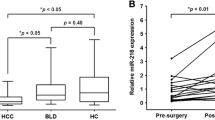Abstract
Previous studies have shown that some microRNAs (miRs) are intensively involved in the development of hepatocellular carcinoma. We analyzed the prognostic role of serum microRNA (miR-122) levels in hepatocellular carcinoma patients using a retrospective design. MiR-122 levels in 122 hepatocellular carcinoma patients were measured, and Cox regression analysis was performed to analyze the prognostic role of miR-122 in hepatocellular carcinoma, and the hazard ratio (HR) with 95 % confidence interval (95 %CI) was used to evaluate its prognostic role. Patients with large tumor size had lower levels of serum miR-122 (P = 0.04). However, there was no significant association of serum miR-122 levels with other clinical characteristics. Kaplan-Meier method showed that there was higher overall survival rate in hepatocellular carcinoma patients with high serum miR-122 levels compared with those with low miR-122 level (P < 0.01). When using Cox regression analysis, high serum miR-122 level was independently associated with better overall survival in hepatocellular carcinoma patients (HR = 0.26; 95 %CI 0.14–0.47, P < 0.01). Subgroup analysis by gender showed that high serum miR-122 level was independently associated with better overall survival in male patients (HR = 0.08; 95 %CI 0.03–0.22, P < 0.01), but not in female patients (HR = 0.48; 95 %CI 0.18–1.32, P = 0.16). Thus, the outcomes in the analysis suggest that high serum miR-122 level is independently associated with higher overall survival rate in hepatocellular carcinoma patients, and it is a good biomarker of better prognosis in patients with hepatocellular carcinoma.


Similar content being viewed by others
References
Lafaro KJ, Demirjian AN, Pawlik TM. Epidemiology of hepatocellular carcinoma. Surg Oncol Clin N Am. 2015;24:1–17.
El-Serag HB, Kanwal F. Epidemiology of hepatocellular carcinoma in the United States: where are we? Where do we go? Hepatology. 2014;60:1767–75.
Bosetti C, Turati F, La Vecchia C. Hepatocellular carcinoma epidemiology. Best Pract Res Clin Gastroenterol. 2014;28:753–70.
Hoshida Y, Fuchs BC, Bardeesy N, Baumert TF, Chung RT. Pathogenesis and prevention of hepatitis C virus-induced hepatocellular carcinoma. J Hepatol. 2014;61:S79–90.
Nault JC. Pathogenesis of hepatocellular carcinoma according to aetiology. Best Pract Res Clin Gastroenterol. 2014;28:937–47.
Yki-Jarvinen H. Non-alcoholic fatty liver disease as a cause and a consequence of metabolic syndrome. Lancet Diabetes Endocrinol. 2014;2:901–10.
Walker JJ, Johnson JA, Wild SH. Diabetes treatments and cancer risk: the importance of considering aspects of drug exposure. Lancet Diabetes Endocrinol. 2013;1:132–9.
Scheen AJ, Van Gaal LF. Combating the dual burden: therapeutic targeting of common pathways in obesity and type 2 diabetes. Lancet Diabetes Endocrinol. 2014;2:911–22.
Bolland MJ, Grey A, Gamble GD, Reid IR. The effect of vitamin d supplementation on skeletal, vascular, or cancer outcomes: a trial sequential meta-analysis. Lancet Diabetes Endocrinol. 2014;2:307–20.
Rich N, Singal AG. Hepatocellular carcinoma tumour markers: current role and expectations. Best Pract Res Clin Gastroenterol. 2014;28:843–53.
Shenoy A, Blelloch RH. Regulation of microRNA function in somatic stem cell proliferation and differentiation. Nat Rev Mol Cell Biol. 2014;15:565–76.
Ha M, Kim VN. Regulation of microRNA biogenesis. Nat Rev Mol Cell Biol. 2014;15:509–24.
Hayes J, Peruzzi PP, Lawler S. MicroRNAs in cancer: biomarkers, functions and therapy. Trends Mol Med. 2014;20:460–9.
Jasinski-Bergner S, Mandelboim O, Seliger B. The role of microRNAs in the control of innate immune response in cancer. J Natl Cancer Inst. 2014;106.
Zhu Z, Zhang X, Wang G, Zheng H. Role of microRNAs in hepatocellular carcinoma. Hepat Mon. 2014;14:e18672.
Lanford RE, Hildebrandt-Eriksen ES, Petri A, Persson R, Lindow M, Munk ME, et al. Therapeutic silencing of microrna-122 in primates with chronic hepatitis C virus infection. Science. 2010;327:198–201.
Jopling C. Liver-specific microRNA-122: biogenesis and function. RNA Biol. 2012;9:137–42.
Waidmann O, Koberle V, Brunner F, Zeuzem S, Piiper A, Kronenberger B. Serum microRNA-122 predicts survival in patients with liver cirrhosis. PLoS One. 2012;7:e45652.
Xu J, Zhu X, Wu L, Yang R, Yang Z, Wang Q, et al. Microrna-122 suppresses cell proliferation and induces cell apoptosis in hepatocellular carcinoma by directly targeting wnt/beta-catenin pathway. Liver Int. 2012;32:752–60.
Tsai WC, Hsu SD, Hsu CS, Lai TC, Chen SJ, Shen R, et al. Microrna-122 plays a critical role in liver homeostasis and hepatocarcinogenesis. J Clin Invest. 2012;122:2884–97.
Qi P, Cheng SQ, Wang H, Li N, Chen YF, Gao CF. Serum microRNAs as biomarkers for hepatocellular carcinoma in Chinese patients with chronic hepatitis B virus infection. PLoS One. 2011;6:e28486.
Thibault PA, Huys A, Dhillon P, Wilson JA. Microrna-122-dependent and -independent replication of hepatitis c virus in hep3b human hepatoma cells. Virology. 2013;436:179–90.
Gupta P, Cairns MJ, Saksena NK. Regulation of gene expression by microRNA in HCV infection and HCV-mediated hepatocellular carcinoma. Virol J. 2014;11:64.
Li C, Wang Y, Wang S, Wu B, Hao J, Fan H, et al. Hepatitis b virus mRNA-mediated mir-122 inhibition upregulates pttg1-binding protein, which promotes hepatocellular carcinoma tumor growth and cell invasion. J Virol. 2013;87:2193–205.
Koberle V, Kronenberger B, Pleli T, Trojan J, Imelmann E, Peveling-Oberhag J, et al. Serum microRNA-1 and microRNA-122 are prognostic markers in patients with hepatocellular carcinoma. Eur J Cancer. 2013;49:3442–9.
Conflicts of interest
None
Author information
Authors and Affiliations
Corresponding author
Rights and permissions
About this article
Cite this article
Xu, Y., Bu, X., Dai, C. et al. High serum microRNA-122 level is independently associated with higher overall survival rate in hepatocellular carcinoma patients. Tumor Biol. 36, 4773–4776 (2015). https://doi.org/10.1007/s13277-015-3128-5
Received:
Accepted:
Published:
Issue Date:
DOI: https://doi.org/10.1007/s13277-015-3128-5




